Slavutych
Slavutych (Ukrainian: Славу́тич) is a city in northern Ukraine, purposely built for the evacuated personnel of the Chernobyl Nuclear Power Plant after the 1986 disaster that occurred near the city of Pripyat. Geographically located within the Ripky Raion, Chernihiv Oblast, Slavutych is administratively subordinated to the Kiev Oblast.[1] In 2014 the city had a population of 25,112 inhabitants.[2]
Slavutych Славу́тич | |
|---|---|
.jpg) One of Slavutych's residential areas | |
 Flag  Coat of arms | |
 | |
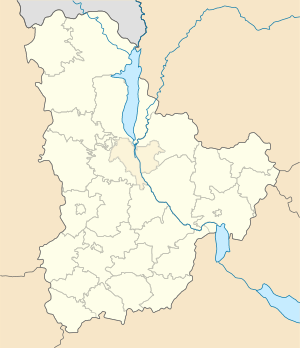 Slavutych Location of Slavutych in Ukraine 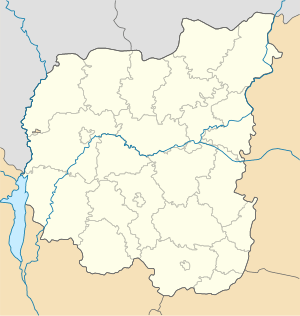 Slavutych Slavutych (Chernihiv Oblast)  Slavutych Slavutych (Ukraine) | |
| Coordinates: 51°31′14″N 30°45′25″E | |
| Country | |
| Oblast | |
| Raion | Vyshhorod Raion[1] |
| Founded | 1986 |
| City rights | 1986 |
| Government | |
| • Mayor | Yurii Fomichev |
| Area | |
| • Total | 2.53 km2 (0.98 sq mi) |
| Population (2014) | |
| • Total | 25,112 |
| • Density | 9,900/km2 (26,000/sq mi) |
| Postal code | 07100 |
| Area code(s) | +380 4579 |
| Website | www |
Geography
.png) Transportation connection between Slavutych and Pripyat (map is in German)
Transportation connection between Slavutych and Pripyat (map is in German)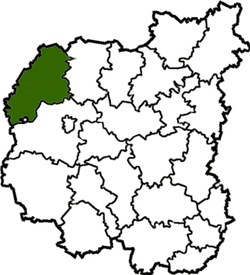 Ripky Raion within Chernihiv Oblast. The non-shaded white dot at the southern edge indicates the city of Slavutych.
Ripky Raion within Chernihiv Oblast. The non-shaded white dot at the southern edge indicates the city of Slavutych.
Slavutych is situated on the left bank of the Dnieper River, 40 kilometers from Chernihiv, 45 kilometers from the city of Pripyat, 50 kilometers from Chernobyl (both in Ivankiv Raion) and 200 kilometers from Kiev. While being geographically located in Ripky Raion (part of Chernihiv Oblast), administratively it belongs to Kiev Oblast. It is an administrative exclave, that prior to 2020 did not belonging to any raion. Prior to 2020 administrative reform the city was qualified as a city of oblast significance).[1] In 2020 Slavutych was downgraded to a city of district significance and made part of Vyshhorod Raion.[1]
History
Slavutych was named after the Old Slavic name (Slavutych) of Dnieper River. The city was built in 1986 shortly after the Chernobyl nuclear disaster, to provide homes for those who had worked at the Chernobyl nuclear power plant and their families. They were evacuated from the abandoned city of Pripyat. The economic and social situation of the city is still heavily influenced by the power plant and other Chernobyl zone installations. Many of the residents still work in the energy industry in the region.
In an interview with Pravda published on October 10, 1986, Erik Pozdyshev, the newly appointed Director of the Chernobyl nuclear power plant, officially announced that a new city was to be built. Construction of the town started shortly thereafter, and the first inhabitants settled in October 1988. The city was intended to replace Pripyat which became a ghost town after it was evacuated thirty-six hours after the nuclear disaster due to the nuclear fallout. There is a memorial in Slavutych to remember the victims of the disaster, especially to those who lost their lives immediately after the event from radiation-related diseases.
The city is mostly home to survivors of the disaster who had to be relocated from the evacuation zone around the reactor, among them about 8,000 people who were children when the disaster occurred. As a result, the number of people who have a radiation-related illness is high. Many inhabitants still work at the site of the former plant for monitoring, maintenance or scientific purposes. They commute to the zone on a regular basis. A rail line (twice crossing the international border with Belarus) runs directly from the city to the site of the plant.
Slavutych is located about 50 kilometers east of the former plant. The site had to be a reasonable distance away from the Chernobyl zone to ensure the risk of radiation-related illnesses was reduced. However, other factors that contributed to the choosing of the site were the availability of a nearby ready railroad infrastructure, and an accessible water supply from the nearby Dnieper River. In order to build the city, the ground was covered with a two-meter layer of uncontaminated soil.
Infrastructures
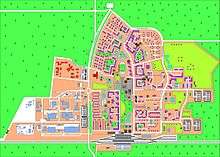 Plan of the city
Plan of the city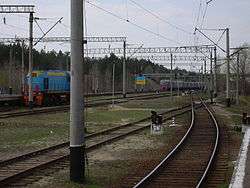 The railway lines at Slavutych station connecting it with the Chernobyl Exclusion Zone
The railway lines at Slavutych station connecting it with the Chernobyl Exclusion Zone- St. Elias church
From the start, Slavutych was planned to become a "21st-century city". Compared to other cities in Ukraine, Slavutych has a modern architecture with pleasant surroundings, and the standard of living in the city is much higher than in most other Ukrainian cities. During the construction of the city, workers and architects from eight former Soviet republics became involved: Armenian SSR, Azerbaijan SSR, Estonian SSR, Georgian SSR, Latvian SSR, Lithuanian SSR, Russian SFSR and Ukrainian SSR. As a result, the city is divided into eight districts named after the capitals of the contributing republics,[3] each with its own unique style and atmosphere. In addition, the city has a youth center, a modern community center, a town hall, an Internet cafe, numerous sports facilities, modern clinics, and a hotel. Around 80% of housing in the city is formed by apartments while the other 20% is formed by small, family houses. The city has a uniquely high birth rate as well as surprisingly low mortality. As a result, the average age in Slavutych is by far the lowest of any city in Ukraine. More than one third of its inhabitants are under 18.
The infrastructure and public facilities of the city are mostly paid by the company which operated the Chernobyl nuclear plant. Because the remaining units of the nuclear power plant were shut down in 2001, the city would face significant social problems and an uncertain future. Until 2001, approximately 9,000 people worked at the plant. Since the shutdown, this number has dropped to 3,000, most of them working on monitoring and maintenance. 85% of the city budget was funded by the operator of the plant. In order to support the settlement and establishment of new companies, Slavutych was declared a Special Economic Zone. In addition, substantial vocational retraining programs are provided by the government to improve the occupational outlook of those who lost jobs. Despite these efforts, about 1,500 people have already left the city, a trend which is predicted to continue for the foreseeable future.
Culture
Slavutych has been the venue of numerous cultural activities since its foundation in 1989. Most recently, the 86 Film and Urbanism Festival[4][5], which ran six editions (2013-2018) and EASA/SESAM[6], which was due to take place in 2020[7], but was postponed to 2021 due to the COVID-19 pandemic.
The unique modernist architecture of the city remains one of its main attractions, as captured in the architectural guide 'Slavutych'[8], by author Ievgeniia Gubkina.
Demographics
| Year | Pop. | ±% |
|---|---|---|
| 1989 | 11,364 | — |
| 2001 | 24,402 | +114.7% |
| 2011 | 24,492 | +0.4% |
| 2012 | 24,726 | +1.0% |
| 2013 | 24,826 | +0.4% |
| 2014 | 25,112 | +1.2% |
Transport
Slavutych has a railway station, and a minor stop in the locality of Poselok Lesnoi, on the Chernihiv–Ovruch line. It is served by a branch (Semenyahivka-Slavutych) of the regional highway P56 Chernihiv-Chernobyl, and by the provincial road T2506.
Personalities
- Serhiy Rozhok (b. 1985), football player
- Ivan Dorn (b. 1988), singer, actor
See also
References
- Where did 354 districts disappear to? Anatomy of loud reform, Glavcom (7 August 2020) (in Ukrainian)
- Чисельність населення на 1 березня 2014 року та середня за січень-лютий 2014 року. oblstat.kiev.ukrstat.gov.ua (in Ukrainian). Retrieved 3 May 2014.
- "Cafebabel: A second life for the inhabitants of Chernobyl". Retrieved 2010-02-27.
- "Міжнародний фестиваль кіно та урбаністики «86»". 86PROKAT. Незалежний кінодистриб'ютор. Retrieved 2020-06-24.
- Burshteyn, Ben Walker, Aleksandra. "Letter from Slavutych: a green city soaring from the ashes of Chernobyl". The Calvert Journal. Retrieved 2020-06-24.
- "SESAM 2020". www.e-flux.com. Retrieved 2020-06-24.
- "SESAM 2020 POLIKLINIKA in Slavutych, Ukraine". ArchDaily. 2019-10-22. Retrieved 2020-06-24.
- "Slavutych". DOM publishers. Retrieved 2020-06-24.
External links
| Wikimedia Commons has media related to Slavutych. |
- (in Ukrainian) Slavutych City Community Website
- Half-Life: Where are the Chernobyl workers now? documentary by Matador Network (January 3, 2012)
- "Memories of the Future: Slavutych Tomorrow" participative art-project by Krolikowski Art dedicated to Slavutych
- "86 International Festival of Film and Urbanism" an annual festival taking place Slavutych, with an Urbanism Program curated by METASITU